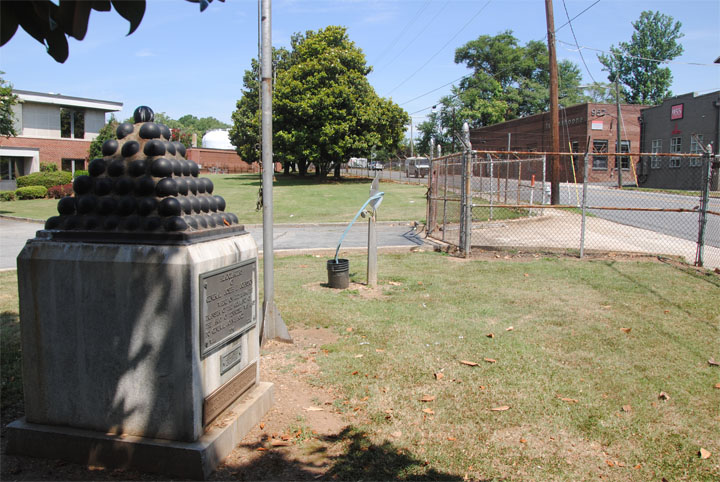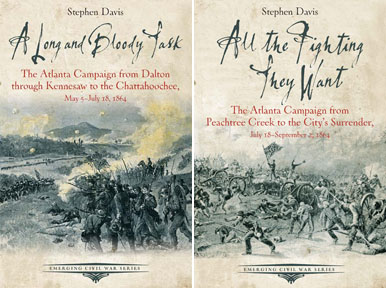
CHAPTER EIGHT: “Far Better in the Present Emergency”:
John Bell Hood Replaces Joseph E. Johnston”
by Stephen Davis
Commentary · Images · Additional Resources · Suggested Reading · About the Author
Commentary
In 2014, in conjunction with the Sesquicentennial anniversary of the Franklin-Nashville Campaign, ECW ran a nine-part series titled “Hood Remembered.”
* * *
Robert E. Lee did not support John Bell Hood’s promotion to command the Army of Tennessee, which Steve Davis discussed in a March 7, 2017 post, “Robert E. Lee and John B. Hood: A Complicated Relationship.”
* * *
ECW’s Chris Mackowski and Lee White considered “The Question of Hood and the Army of Tennessee: ‘Far Better’ or ‘Far Better?’” in a Nov. 30, 2017, post.
Images

John Bell Hood and Joseph E. Johnston represented a study in contrast. Hood, one of the “young turks” of the Confederacy, had proven himself an aggressive, capable division commander in the Army of Northern Virginia before transferring to the West. Johnston, the model of cautious reserve, had built his reputation through years of service in the prewar army, including notable service during the Mexican War. (credit both: Library of Congress)
* * *

Johnston gave ground all spring and into the summer, looking for an opening to strike at the Federal army group that pressed him. After Federals outmaneuvered him from his strong defenses along Kennessaw Mount, Johnston crossed the Chattahoochee River (above) without offering—or even planning—a strong resistance. The move seemed to be the last straw for Confederate President Jefferson Davis. (credit: Steve Davis)
* * *

Davis sought advice about the Johnston situation from several key figures, including Texas Sen. Louis T. Wigfall, who visited with Johnston while passing through the area; his top military adviser, Braxton Bragg, whom Johnston had replaced at the head of the Army of Tennessee and so whom had little love lost for Johnston; and Secretary of War James Seddon. (credits: Library of Congress, Library of Congress, Wikipedia Commons)
* * *
 Johnston did have his supporters, including Georgia governor Joe Brown, who enlisted the aid of the state’s senior senator, Benjamin Harvey Hill, in trying to clarify Johnston’s plans. (credit both: Library of Congress)
Johnston did have his supporters, including Georgia governor Joe Brown, who enlisted the aid of the state’s senior senator, Benjamin Harvey Hill, in trying to clarify Johnston’s plans. (credit both: Library of Congress)
* * *
Johnston was at his headquarters, the home of Dexter Niles house, when he received word from Richmond that he’d been relieved of command. The house was destroyed by the end of 1864, and the site later swallowed up by development. A monument erected by the United Daughters of the Confederacy now marks the spot at 1042 Marietta Street which is now located in an industrial area. (credit for both: Atlanta History Center)


Additional Resources
Steve Davis presented on John Bell Hood and the Atlanta Campaign at the Third Annual Emerging Civil War Symposium at Stevenson Ridge. His talk appeared on C-SPAN 3, which you can view here.
John Bell Hood wrote his memoirs, Advance and Retreat, which you can read online here.
In the early 2000’s, a cache of lost Hood papers was discovered, published in 2015 by Savas Beatie as The Lost Papers of John Bell Hood. The Hood descendant who husbanded that project was Sam Hood, who wrote a new biography of his ancestor, John Bell Hood: The Rise, Fall, and Resurrection of a Confederate General. Sam Hood also wrote a four-part series about John Bell Hood for ECW, “Hood on Hood.”
You can read more ECW stories about John Bell Hood here.
You can read more ECW stories about the Atlanta Campaign here.
The Civil War Trust’s “In4” video series features a segment about the Atlanta Campaign, hosted by historian Doug Ullman, that you can watch here.
Suggested Reading
 Steve Davis has written about the Atlanta Campaign extensively. You can check out his two volumes in the Emerging Civil War Series, A Long and Bloody Task: The Atlanta Campaign from Dalton through Kennesaw to the Chattahoochee and All the Fighting They Want:The Atlanta Campaign from Peachtree Creek to the City’s Surrender (Savas Beatie, 2016 & 2017). He has more in-depth treatments of the action around Atlanta, as well: What the Yankees Did to Us: Sherman’s Bombardment and Wrecking of Atlanta (Mercer University Press, 2012) and Atlanta Will Fall: Sherman, Joe Johnston, and the Yankee Heavy Battalions (Rowman Littlefield, 2001).
Steve Davis has written about the Atlanta Campaign extensively. You can check out his two volumes in the Emerging Civil War Series, A Long and Bloody Task: The Atlanta Campaign from Dalton through Kennesaw to the Chattahoochee and All the Fighting They Want:The Atlanta Campaign from Peachtree Creek to the City’s Surrender (Savas Beatie, 2016 & 2017). He has more in-depth treatments of the action around Atlanta, as well: What the Yankees Did to Us: Sherman’s Bombardment and Wrecking of Atlanta (Mercer University Press, 2012) and Atlanta Will Fall: Sherman, Joe Johnston, and the Yankee Heavy Battalions (Rowman Littlefield, 2001).
· Bonds, Russell S. War Like the Thunderbolt: The Battle and Burning of Atlanta (Westholme Publishing, 2009)
· Castel, Albert. Decision in the West: The Atlanta Campaign of 1864 (University Press of Kansas, 1992)
· Ecelbarger, Gary. The Day Dixie Died: The Battle of Atlanta (St. Martin’s Press, 2010)
· Jenkins, Robert D. The Battle of Peach Tree Creek: Hood’s First Sortie, July 20, 1864 (Mercer University Press, 2013)
· McMurry, Richard M. Atlanta 1864: Last Chance for the Confederacy (Bison Books, 2001)
About the Author
 Stephen Davis, of Atlanta, wrote a feature article about fighting around Atlanta for a special issue of Blue and Gray Magazine in August 1989. His book Atlanta Will Fall: Sherman, Joe Johnston, and the Heavy Yankee Battalions (2001) is a campaign narrative. His What the Yankees Did to Us: Sherman’s Bombardment and Wrecking of Atlanta (2012) chronicles the city’s encounter with war and enemy occupation. Davis is the author of two books on the Atlanta campaign for the Emerging Civil War Series, as well as a study of John B. Hood’s generalship in 1864.
Stephen Davis, of Atlanta, wrote a feature article about fighting around Atlanta for a special issue of Blue and Gray Magazine in August 1989. His book Atlanta Will Fall: Sherman, Joe Johnston, and the Heavy Yankee Battalions (2001) is a campaign narrative. His What the Yankees Did to Us: Sherman’s Bombardment and Wrecking of Atlanta (2012) chronicles the city’s encounter with war and enemy occupation. Davis is the author of two books on the Atlanta campaign for the Emerging Civil War Series, as well as a study of John B. Hood’s generalship in 1864.
